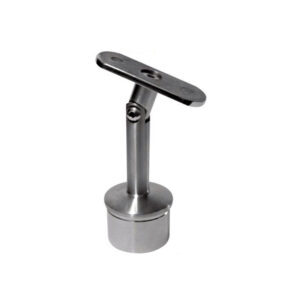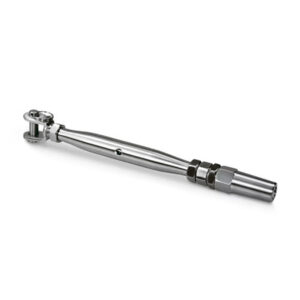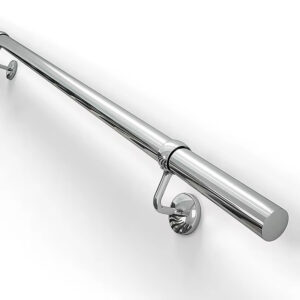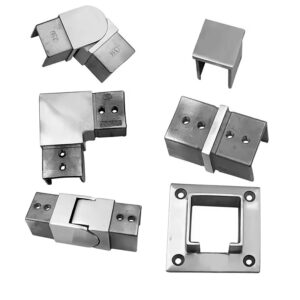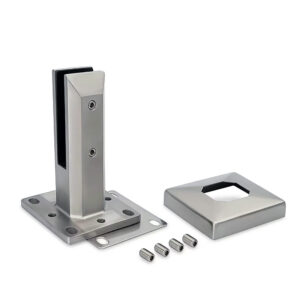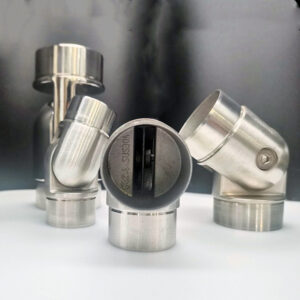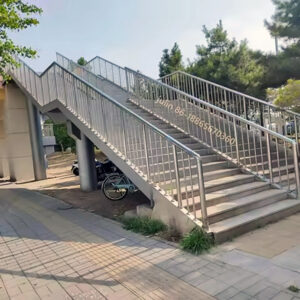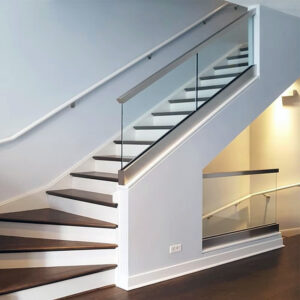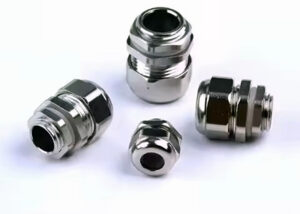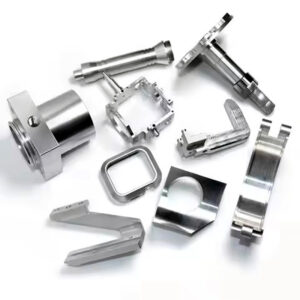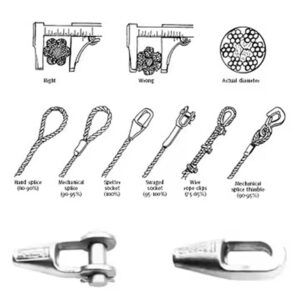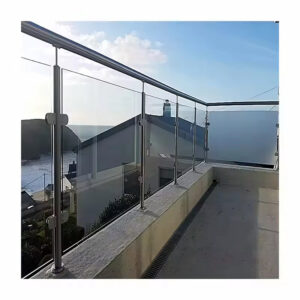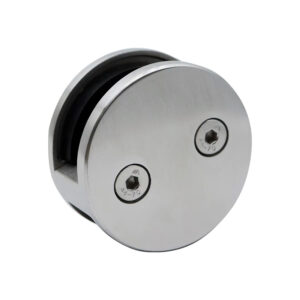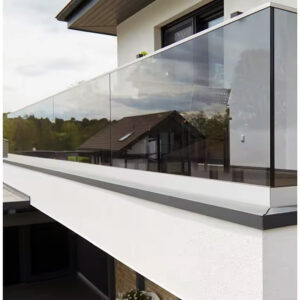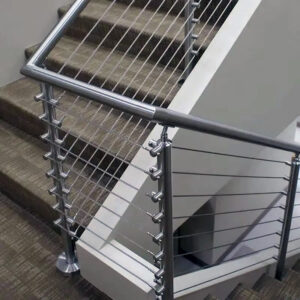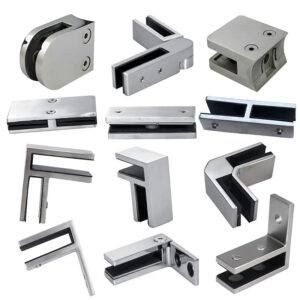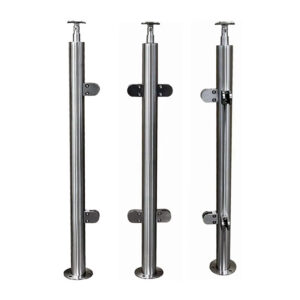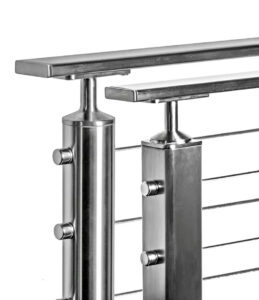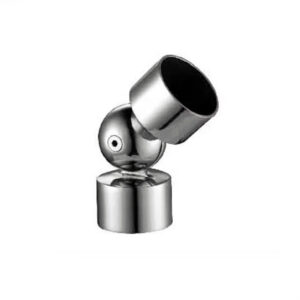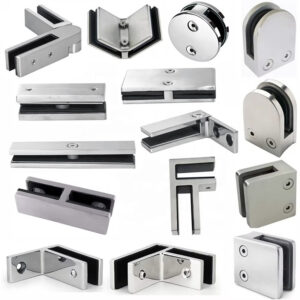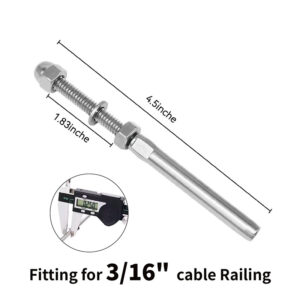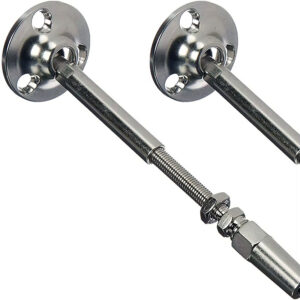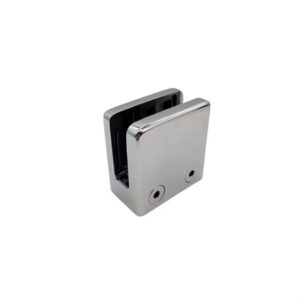When your project demands reliable performance under constant use, standard railing solutions often fall short. High traffic railing systems require precision engineering, proven materials, and components that actually work together. After 23 years manufacturing stainless steel hardware, we’ve learned what separates systems that perform from those that create problems. Whether you’re specifying for commercial buildings, industrial facilities, or multi-unit housing, the right system integration makes the difference between smooth installation and costly delays.
Complete High Traffic Railing Systems That Work
Engineered Handrail Systems
Our high traffic railing systems start with handrail components designed for continuous use. Wall-mounted, post-supported, and surface-mounted configurations use standardized mounting points that align with common construction practices. Each system includes pre-engineered brackets, continuous rail sections, and joining hardware that eliminates field guesswork.
The modular approach means fewer unique parts in inventory while maintaining design flexibility. Contractors report 30-40% faster installation compared to custom fabrication, with consistent results across multiple projects.
Heavy-Duty Post and Rail Components
High traffic fabrication 316L stainless posts handle the structural loads while maintaining corrosion resistance in demanding environments. Standard post diameters (1.5″, 2″, 2.5″) work with engineered rail systems, glass panels, or cable infill options. Pre-drilled mounting patterns and adjustable base plates accommodate real-world construction tolerances.
Post spacing calculations follow IBC load requirements, with engineering data available for specific applications. The precision high traffic components eliminate the trial-and-error common with mixed-vendor systems.
Glass Railing Integration
Glass panel systems require specialized hardware that maintains structural integrity under lateral loads. Our commercial high traffic systems include glass clamps, standoffs, base shoes, and continuous glazing supports engineered for public use applications.
316L stainless hardware resists the accelerated corrosion common in high-traffic areas. Pre-engineered glass thickness compatibility (1/2″, 5/8″, 3/4″) simplifies specification and reduces installation variables.
Cable Railing Systems for High Use
Cable systems provide modern aesthetics with practical durability. Through-post cable routing, adjustable tensioners, and corrosion-resistant hardware maintain proper tension under temperature cycling and structural movement. Our ODM high traffic railing manufacturing experience shows that properly engineered cable systems require minimal maintenance when installed correctly.
Standard cable spacing meets IBC sphere requirements, with hardware designed for field adjustment without special tools.
Material Engineering That Performs
304 stainless works for most interior applications and protected exteriors. 316L stainless handles marine environments, chemical exposure, and areas with road salt or industrial contamination. Our high traffic fabrication 316L components use solution annealing for maximum corrosion resistance.
Surface finishes balance durability with maintenance requirements. Brushed finishes hide minor scratches and wear patterns common in high-use areas. Mirror finishes provide premium appearance but require more frequent cleaning.
Esang Metal has refined these material specifications through 23 years of manufacturing experience, including projects that failed with inferior materials.
▶ Get Technical Specifications ◀
Performance Data That Matters
| Component Type | Load Capacity (lbs) | Material Grade | Installation Time |
|---|---|---|---|
| Wall-Mount Handrail | 200 linear load | 304/316L | 15 min/10 ft |
| Post-Mount System | 50 lb concentrated | 316L structure | 45 min/post |
| Glass Panel Mount | 50 lb/ft² lateral | 316L hardware | 30 min/panel |
| Cable Rail System | 200 lb top rail | 316L fittings | 20 min/bay |
| Environment | 304 Stainless | 316L Stainless | Maintenance Interval |
|---|---|---|---|
| Interior/Dry | Excellent | Excellent | Annual inspection |
| Exterior/Urban | Good | Excellent | 6-month cleaning |
| Coastal/Marine | Not recommended | Excellent | Quarterly maintenance |
| Industrial/Chemical | Limited use | Excellent | Monthly inspection |
“Standardized railing systems reduce installation time up to 40% while improving code compliance consistency.” —National Association of Building Contractors
Real Applications, Proven Results
Commercial Building Performance
Office complexes and retail centers demand systems that handle daily use without constant maintenance. Our commercial high traffic systems have performed in major installations including downtown office towers and shopping centers. One 12-story office project used standardized post-and-rail systems throughout, cutting installation time from 6 weeks to 3.5 weeks compared to custom fabrication.
The modular design allowed the contractor to pre-install handrail brackets during rough construction, then add rails during finish work. This sequencing flexibility prevented trade conflicts and reduced overall project time.
Multi-Unit Housing Efficiency
Apartment buildings and condominiums benefit from standardized systems across multiple units. A 200-unit housing project used identical stair and balcony railings, allowing bulk purchasing and streamlined installation. The contractor reported 50% reduction in installation variables and faster crew training.
Maintenance consistency across units simplifies property management. Standard replacement parts and known maintenance schedules help property managers budget accurately.
Industrial Facility Durability
Manufacturing plants and warehouses require railings that withstand heavy use plus exposure to chemicals, temperature cycling, and potential impact. Our precision high traffic components include reinforced mounting hardware and 316L construction where environmental conditions demand it.
A chemical processing facility installation has operated 8 years with minimal maintenance beyond scheduled cleaning. The high traffic fabrication 316L materials resist the acidic environment that degraded previous carbon steel systems.
“Modular railing design eliminated costly field modifications and reduced our installation schedule significantly.” —Regional Commercial Contractors Association
▶ Discuss Your Project Requirements ◀
Installation Support That Works
Pre-Engineering Advantages
Our 23 years of manufacturing experience shows that installation problems usually trace to poor component integration. High traffic railing systems use pre-engineered connections, standardized hardware, and detailed assembly instructions that eliminate guesswork.
Post base plates include slotted mounting holes for construction tolerance accommodation. Handrail brackets align with standard stud spacing while allowing field adjustment for specific conditions.
Quality Control That Prevents Problems
Manufacturing precision ensures components fit correctly the first time. CNC machining maintains consistent hole patterns and dimensions across production runs. This eliminates the field drilling and modification common with lower-precision suppliers.
Each shipment includes installation drawings specific to the ordered configuration. Hardware quantities match exactly with no excess waste or missing pieces.
▶ Talk to Our Installation Engineers ◀
Frequently Asked Questions
Q: How do I choose between 304 and 316L stainless for high traffic applications?
A: 304 stainless works for interior and most exterior applications. Choose 316L for coastal areas, industrial environments, or anywhere road salt exposure occurs. The material cost difference is typically 15-20%, but 316L prevents premature replacement in corrosive environments.
Q: What’s the realistic installation time for commercial projects?
A: Standardized systems typically install 40% faster than custom fabrication. A typical commercial stair system with handrails takes 4-6 hours versus 8-10 hours for field-fabricated systems. Complex configurations may require additional time for layout.
Q: How do modular systems handle unique architectural requirements?
A: Our ODM high traffic railing manufacturing capabilities customize standard components for specific needs. This maintains system integration benefits while accommodating architectural details. Custom work typically adds 2-3 weeks to delivery but eliminates field modification.
Q: What maintenance should be expected with high traffic systems?
A: Properly specified systems require minimal maintenance. Interior installations need annual inspection and cleaning. Exterior systems require 6-month cleaning in urban environments, quarterly maintenance in coastal areas. Our 23-year experience shows that material selection affects long-term costs more than initial installation.
System Comparison and Selection
| Feature | Standard Fabrication | Modular Systems | Custom Integration |
|---|---|---|---|
| Installation Speed | Baseline | 40% faster | 20% faster |
| Component Consistency | Variable | High | High |
| Inventory Complexity | High | Low | Medium |
| Field Modification | Common | Rare | Minimal |
| Long-term Support | Limited | Standardized | Engineering backed |
Different projects require different approaches. High-volume installations benefit most from standardized systems. Unique architectural features may justify custom engineering. Our role is matching system capabilities with project requirements based on 23 years of manufacturing various solutions.
“System reliability depends more on proper material selection and component integration than initial cost savings.” —Building Hardware Performance Institute
▶ Connect with Our Technical Team ◀
The difference between successful high traffic railing systems and problematic installations often comes down to component integration and material specification. Our manufacturing experience has shown what works across diverse applications, from basic commercial installations to complex industrial environments. Whether your project needs standard solutions or custom engineering, the key is matching system capabilities with actual performance requirements.
